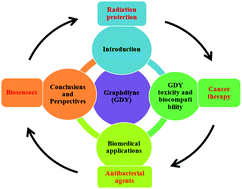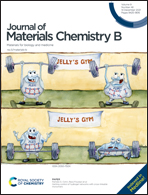Recent development in graphdiyne and its derivative materials for novel biomedical applications
Abstract
Graphdiyne (GDY), which possess sp- and sp2-hybridized carbon and Dirac cones, offers unique physical and chemical properties, including an adjustable intrinsic bandgap, excellent charge carrier transfer efficiency, and superior conductivity compared to other carbon allotropes. These exceptional qualities of GDY and its derivatives have been successfully used in a variety of fields, including catalysis, energy, environmental protection, and biological applications. Herein, we focus on the potential application of GDY and its derivatives in the biomedical domain, including biosensing, biological protection, cancer therapy, and antibacterial agents, demonstrating how the biomimetic behavior of these materials can be a step forward in bridging the gap between nature and applications. Considering the excellent biocompatibility, solubility and selectivity of GDY and its derived materials, they have shown great potential as biosensing and bio-imaging materials. The unusual combination of properties in GDY has been used in biological applications such as “OFF–ON” DNA detection and enzymatic sensing, where GDY has a greater adsorption capacity than graphene and other 2D materials, resulting in increased sensitivity. GDY and its derivatives have also been used in cancer treatment due to their high doxorubicin (DOX) loading capacity (using-stacking) and photothermal conversion ability, and radiation protection since their initial biological use. The poor biodegradation rate of graphene demands the search for new nanomaterials. Accordingly, GDY has better biocompatibility and bio-safety than other 2D nanomaterials, especially graphene and its oxide, due to its absence of aggregation in the physiological environment. Thus, GDY-based nanomaterials have become promising candidates as bio-delivery carriers. Besides, GDY and GDY-based materials have also shown interesting applications in the fields of cell-culture, cell-growth and tissue engineering. Herein, we present a comprehensive review on the applications of GDY and its derivatives as biomedical materials, followed by their future perspectives. This review will provide an outlook for the application of graphene and its derivatives and may open up new horizons to inspire broader interests across various disciplines. Finally, the future prospects for GDY-based materials are examined for their potential biological use.

- This article is part of the themed collection: Journal of Materials Chemistry B Recent Review Articles


 Please wait while we load your content...
Please wait while we load your content...